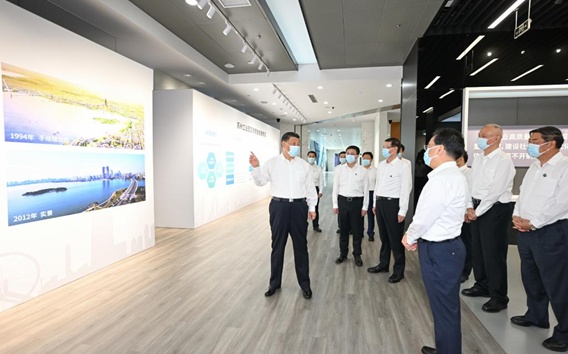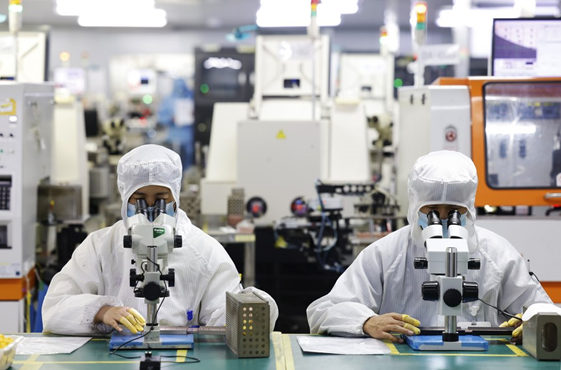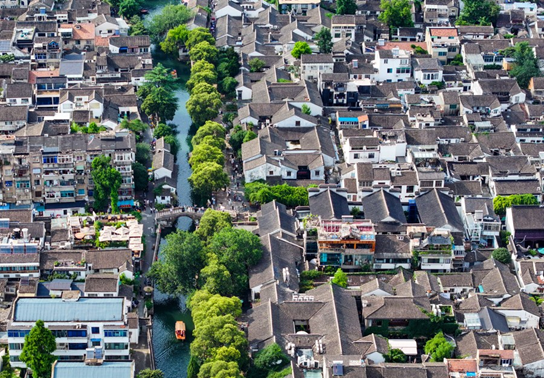President Xi Jinping’s July 5-7 inspection tour of Jiangsu Province – east China’s economic powerhouse – polarized global attention. The province’s GDP exceeded RMB 12 trillion in 2022, making Jiangsu second only to Guangdong, among China’s provincial regions, in surpassing the RMB12 trillion mark. Its value-added manufacturing industry output, meanwhile, accounted for 37.3 percent of Jiangsu’s GDP – the highest ratio among China’s provincial-level regions. In the same year the province’s output in the emerging sectors of strategic importance reached 40.8 percent, and that of its hi-tech manufacturing increased by 10.8 percent. More importantly, the province’s per capita disposable income reached RMB 49,862 in 2022, as compared with the national average of RMB 36,883.
In view of Jiangsu’s solid industrial foundation, rich scientific and educational resources, sound business environment, and huge market, President Xi urged the province to take the lead as exemplar of China’s advancing modernization.
Innovation Stronghold
Jiangsu is at the forefront of China’s sci-tech innovation landscape. In 2022, the province’s research and development investment of RMB 370 billion contributed around 12 percent to the national total, the technological share of its economic growth having reached 67 percent. Jiangsu’s innovation capacity has maintained its place among the country’s leaders in this regard for some years.

Chinese President Xi Jinping visits the exhibition center of the Suzhou Industrial Park in Suzhou, east China's Jiangsu Province, on July 5, 2023. (Xinhua/Xie Huanchi)
During his visit to Suzhou Industrial Park – an important intergovernmental cooperation project between China and Singapore – President Xi noted the significant and historically glorious role of such hi-tech parks in China’s pursuit of technological self-reliance and strength. Since its founding in 1994, Suzhou Industrial Park has transformed a suburban expanse of paddy fields and fish ponds into a hotbed of innovation and openness. Home to more than 2,400 national hi-tech firms, the park is also site of 100 or more Fortune Global 500 companies. It has, moreover, nurtured 17 companies listed on China’s sci-tech innovation board. Its GDP having logged RMB 351.5 billion in 2022, Suzhou Industrial Park has retained pole position in the country’s comprehensive evaluation test of national economic and technological development zones for seven consecutive years.
Nationwide, national hi-tech industrial development zones (including Suzhou Industrial Park) number 169. Expected to exceed 220 by 2025, according to the national 2021-2025 plan for hi-tech industrial development zones released by Ministry of Science and Technology, they are an important engine to advance the country’s high-quality development. In 2021, the 169 national hi-tech zones’ total revenue amounted to RMB 47.8 trillion, 2.9 times the 2012 figure. Encompassing 84 percent of national key laboratories and 78 percent of national technological innovation centers, these hi-tech zones are the country’s core force in technological breakthroughs that will hone the country’s independent innovation capability.
Xi noted that science and technology is the key to Chinese modernization, and that Jiangsu should lead breakthroughs in this regard by building a national industrial sci-tech hub of technological innovation that powers the province’s high-quality development.
In light of national strategic demands and the province’s pressing needs for industrial development, Jiangsu Province attaches great importance to building major sci-tech platforms. Some of its major laboratories now constitute the country’s core strategic sci-technology force. They include Purple Mountain Laboratories, which achieved a 206.25 gigabit per second (Gbps) wireless transmission speed – a world record in sixth-generation (6G) mobile network technology for real-time wireless transmission – and Taihu Laboratory, a world-scale deep sea science and technology facility. Growingly tailored to major industrial demands for technological innovation, Jiangsu has annually expedited around 200 key projects in recent years. An example in point is that of the research team headed by Tan Hairen of Nanjing University that formulated the Perovskite cell (PSC), the most efficient version yet of solar power technology, which absorbs light and could potentially provide a low-cost source of solar power. A reviewer for Nature journal commended the team’s “very meaningful result in this field.” The PSC can, moreover, be mass-produced at half the cost of traditional silicon cells. Its high efficiency, low cost, and minimal environmental impact has made PSC one of the most efficient and affordable solar power technologies today.
The province’s18 nation-level hi-tech development zones and 13 national innovative cities take it to the top of China’s list in this regard.
Manufacturing Hub
Jiangsu’s core competency lies in its real economy, its manufacturing industry scale having long maintained a national first place, and also as site of the country’s most advanced manufacturing industry clusters. In 2022, the value-added output of Jiangsu's manufacturing industry accounted for 37.3 percent of its GDP, exceeding RMB 4 trillion – the highest ratio among China’s provincial-level regions. The province has fostered around 20 advanced manufacturing clusters and 50 key industrial chains in sectors that include the Internet of Things (IoT), engineering machinery, and wind power equipment.
President Xi emphasized during his Jiangsu tour the imperatives of dovetailing technological industrial innovation, the deep integration of industries, universities, and research institutes with enterprises as a mainstay, and promoting the industrial application of scientific and technological achievements, as well as continuously nurturing new industries and leading industrial upgrading through new technologies.

Workers make chips for export at an electronics company in Sihong, east China's Jiangsu Province, on February 23, 2022. (Photo by Xu Changliang/Xinhua)
Enterprises play an ever more important role in Jiangsu’s industrial innovation and hi-tech applications. At present, 85 percent of R&D investment comes from enterprises, which are also the source of 70 percent of patented inventions. The province’s enterprises have hosted around 140 national technical centers; meanwhile, Jiangsu continues to nurture leading manufacturing giants. It is also home to 191 enterprises whose revenues exceed RMB 10 billion, and that of 13 of them exceeds RMB 100 billion. Jiangsu is now site of 186 leading firms in various manufacturing sectors.
Moreover, the province has also blazed a trail in fostering advanced manufacturing clusters. The Suzhou High-Speed Rail New Town, about a 20-minute train ride from Shanghai, has attracted 100 or more autonomous vehicle industry companies, specializing in software algorithms, environment sensing, and communications networks, among others, according to Xinhua. Driverless vehicles are hence often to be seen smoothly conveying goods and people along specially renovated smart roads. South Jiangsu’s Wuxi, once known as the “Land of Fish and Rice,” is now the center of China’s IoT industry, and site of 3,000 or more related companies that lead the formulation of more than half of international IoT standards. Over the past 10 years Wuxi’s IoT industry revenues have generated an average yearly growth in excess of 27 percent.
Meanwhile, the province has made headway in intelligent industrial transformation. At the end of 2022, the 187,000 5G base stations that have been built across Jiangsu had achieved full 5G coverage of all its urban areas, thus providing a solid foundation for the province’s smart manufacturing. The digital economy has massively boosted the province's transformation and development on a scale which, in 2021, exceeded RMB 5 trillion, accounting for 11.8 percent of the country’s total, according to Governor of Jiangsu Xu Kunlin. And in the same year Jiangsu built 52 smart manufacturing demonstration factories and 1,639 intelligent workshops.
Cultural Root
President Xi noted during his tour of Jiangsu that building a modern Chinese civilization is essential to advancing Chinese modernization. He hence called on Jiangsu to reinforce its protection, inheritance, and innovative development of China’s fine traditional culture through proactive participation in constructing the Yangtze River National Cultural Park and the Grand Canal National Cultural Park.
Jiangsu has since ancient times been the so-called “Granary of China” whose agricultural influence has been worldwide. In modern times, having led the country’s modern industrial development, Jiangsu experienced a proliferation of booming cities and towns. However, as far back as the Southern Song Dynasty (1127–1279), the region’s urbanization rate exceeded 20 percent. Today, therefore, Jiangsu is the province with the most – 13 – state-listed famous historical and culture cities. Marco Polo once dubbed the City of Suzhou, which has a history of more than 2,500 years, an Oriental Venice. All these accolades have engendered the region’s unique and splendid culture. It is site of China’s first teacher training school, folk museum, and textile, embroidery, and drama schools. Apart from such tangible cultural heritage sites as the water-towns on the lower reaches of the Yangtze River and the ancient fortified fortress in Nanjing’s Stone City, the province also abounds in intangible cultural heritage, including the Nanjing gold foil forging technique, the guqin (a classical stringed instrument) craft, Yangzhou lacquerware painting artistry, and the Yixing red stoneware-making skill.

This aerial photo taken on July 3, 2023 shows a view of a historic and cultural block of Pingjiang Road in Suzhou, east China's Jiangsu Province. (Xinhua/Li Bo)
The crisscrossing river network and Beijing-Hangzhou Grand Canal promoted Jiangsu’s economic growth as well as nurturing its rich culture. During the Qing Dynasty (1644-1911) around half of the country’s top scholars excelling in the imperial examinations came from Jiangsu. Nowadays, statistics show that among all academicians at both the Chinese Academy of Sciences and Chinese Academy of Engineering, those hailing from Jiangsu outnumber the rest.
Jiangsu is now going all out to be instrumental in making China a country with strong cultural confidence. For example, Yangzhou has selected the most prosperous areas easily accessible to local citizens whereon to construct urban studies, thus shaping its reading circle to within a 15-minute walking distance from their homes. There are 51 such urban studies in Yangzhou’s downtown region. Meanwhile, in the interests of preserving and promoting Grand Canal culture, the country’s first modern comprehensive canal-themed museum opened in Yangzhou in 2021. With the theme “the beautiful life that the Grand Canal brings to the people,” the museum houses more than 10,000 cultural relics reflecting the history of the canal from the Spring and Autumn period through to contemporary times. The museum has received more than 4 million visits.
The Pingjiang Historic and Cultural Block, which President Xi visited in July, is located in Suzhou’s northeastern corner, and has a history of more than 2,500 years. Retaining its ancient layout of the waterway running parallel with land roads, the block also displays the distinctively ancient architectural style of white-walled, black-tiled buildings and stone bridges. After observing the making of Suzhou embroidery and woodblock printing of New Year pictures, President Xi commended the Pingjiang block as an invaluable treasure, both in preserving and carrying forward fine traditional Chinese culture and promoting socialist cultural-ethical progress. “Through Suzhou embroidery, we can see how traditional Chinese culture has been passed on from generation to generation,” Xi said. “It epitomizes the resilience, patience and perseverance of the Chinese people, which is part of the Chinese national spirit.”